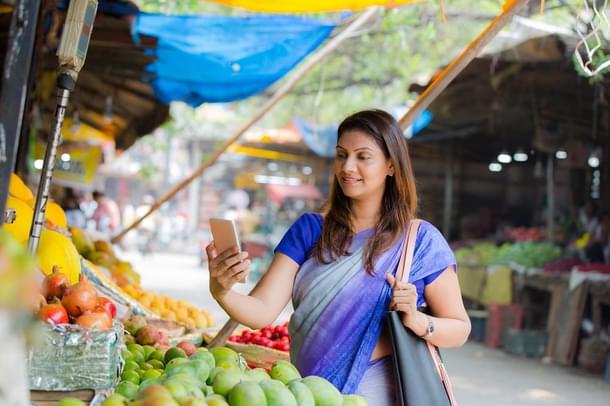Business
Why India’s UPI Could See 50 Billion Transactions Per Month In 5 Years
Tushar Gupta
Nov 02, 2021, 12:04 PM | Updated 12:13 PM IST
Save & read from anywhere!
Bookmark stories for easy access on any device or the Swarajya app.


Continuing its upward trajectory, the Unified Payments Interface (UPI) clocked 4.22 billion transactions in the month of October, registering an increase from 3.66 billion transactions in the preceding month.
The corresponding transaction value also spiked from Rs. 6.54 lakh crore to Rs. 7.71 lakh crore. This was the first month when the UPI crossed $100 billion in transaction value since its inception.
The story of UPI is also a testament to the success of Digital India, especially after the demonetisation of 2016. What was once touted as a platform that would only cater to a few urban pockets, has quickly become ‘the’ payment interface for India, from buyers to sellers, from merchants as big as jewellers to as small as coconut sellers.
Today, coming across street vendors with nothing more than a bicycle and yet being able to offer an option to pay digitally is not uncommon anymore.
What complemented the success of UPI was the JAM Trinity of the government, ensuring bank accounts reach the rural population, linked to their Aadhar cards and mobile phones.
While the sceptics on the Left declared that Jan Dhan accounts would be without any money or activity and thus an exercise in futility, today, more than 43 crore Jan Dhan accounts, or an account for every third person in India, harbour more than Rs. 146,000 crore.
However, even at more than 4 billion transactions, the success story of UPI is barely underway. The makers must be credited for engineering the growth of UPI as well as companies that ushered their respective payment platforms using the open application programming interface (APIs) like Paytm, PhonePe, WhatsApp, and Google.
Yet, even while going from 21 banks, and 0.09 million transactions and Rs. 0.38 crore in transaction value in July 2016, to 261 banks, and more than 4.2 billion transactions, and more than Rs. 7.71 lakh crore transaction value today, UPI, as a payment interface, is a universe apart from peaking, and by virtue of the projected internet penetration and growth in India, especially rural India, merely a 10 per cent of where it could be in the next five years — at 50 billion transactions per month.
Yes, 50 billion.
Firstly, even at 4.2 billion transactions, the number of transactions, per individual, per month, on an average, if one factors a billion people is 4. Eliminate another 400 million citizens without the internet and it comes to down to roughly 7 transactions per month per individual.
If the holders of only Jan Dhan Accounts are factored, even then the average number of transactions is no more than 10.
India is set to register a billion internet users by the national elections of 2024, and has the future of retail moves online, or even in the virtual reality of the metaverse, more and more users will get accustomed to the UPI platform.
As ATMs and debit cards become obsolete, it will be the emergence of UPI in untapped markets and rural pockets that will become the norm for payments.
Clocking 50 billion transactions per month, for UPI, within the next five years, is no arduous task. Assuming a billion internet users, each making 50 transactions per month on an average, is quite simple.
For instance, a simple street vendor can register 100 transactions on a daily basis through UPI in pockets of Bengaluru, Noida, and Pune today. In many supermarkets, 50-100 transactions through any UPI platform is a routine affair.
Thus, it is something that will scale naturally, and the biggest industries that will enable this growth would be FMCG in retail and food and beverages.
The enabler for the 50 billion transactions per month inevitability would be rural India’s shift from 2G and 3G to 4G and urban India’s adoption of 5G.
At any point of time beyond 2026, India could well be looking at 800 million 4G users and 200 million+ 5G users on mobile, to be on the conservative side of things.
Already, Jio has been conducting 5G trials along with Bharti Airtel and Vodafone Idea and has achieved a speed of up to 1Gbps. While Ambani has pledged to be the first to launch 5G services in India, he also voiced his ambition about the JioPhone spearheading ‘2G-mukt’ India drive.
The phone and the consequential cheap internet services are expected to result in more internet inclusion across rural India.
Jio’s attempt to cater to over 300 million customers, still using 2G, is ideal. Given the biggest hindrance to customers still on 2G using feature phones, is the pricing of the smartphones, even the cheapest Androids.
However, the launch of the JioPhone with financing is expected to create a new market for Jio’s 4G services. To complement their hardware and internet infrastructure, Jio is already investing hugely in Jio Retail.
There is also the emergence of superapps that would power the growth of UPI. Amazon, Tatas, Reliance, Flipkart and even Facebook at some point would compete with each other in the superapps realm.
As is the case with Amazon Pay, there would be an incentive for the users like promotional discounts, cashbacks, and other utilities like pay-later or credit lines to adopt the UPI platform.
If one is to estimate the potential of the super-app in the works, a reference to WeChat’s mini-apps or mini-programs as they are called in China can be helpful.
By 2020, WeChat had more than 1.2 billion active users. However, the number of mini-apps on the app was more than 3.2 million by the beginning of 2020. These mini-apps, built within the main app interface, attracted 491 million users on an average per month by June 2018. A year later, this number had swelled by 50 per cent to more than 746 million users.
From a seller's perspective, there is enough incentive to adopt the UPI platform, thanks to the inception of the account aggregator platform.
Even today, the lack of access to formal credit is a hindrance for many small traders who are not looking for loans of more than Rs. 20,000. For some, weekly loans as little as Rs. 5,000 also suffice.
While banks, with their paperwork and manpower, have little motivation to process such mini-loans, it is the account aggregators that could well become the enablers for formal credit for such traders by bridging the gap between them and the financial institutions.
Therefore, for traders looking to avail loans for the first-time, or availing loans on a regular basis, adopting the digital payments system would result in an elaborate credit history that would make them eligible for more loans.
This would, as a consequence, drive the adoption of the UPI platform even further.
What about the transaction value, one wonders?
At 4.2 billion transactions, the transaction value is already more than Rs. 7.71 lakh crore, and for a volume more than 10x of what it is today, the value is hard to estimate because of the scale of it.
50 billion transactions, per month, by 2026?
Not a matter of ‘if’ but ‘how soon’.
Tushar is a senior-sub-editor at Swarajya. He tweets at @Tushar15_





